I've become a Basquetcase.
I've become a Basquetcase.
-
-
-
-
-
-
Post #61 - January 15th, 2014, 2:08 pmMy wife and I celebrated an enchanting honeymoon in the Spanish state of Gipuzkoa, the heart of Basque Country. We stayed in the cider producing town of Astigarraga just 8Km south of San Sebastián (I will cover some of the local cider culture in a forthcoming post). Our accommodations were about as charming as could be, a hobbit house-esque 16th century farmhouse owned by an incredibly hospitable family who rent out their second floor to travelers, also known as a Casa Rural. We rented a car which we found essential to both accessing our place out in the sticks as well as cruising around the coast and mountains. The white knuckled crawl up the side of the mountain was pretty terrifying the first few rides, but the sprawling vista of the mountains, city, and sea from our balcony made for a perfectly romantic setting. I highly recommend seeking out this type of accommodation (which apparently are widespread allover the Spanish countryside).
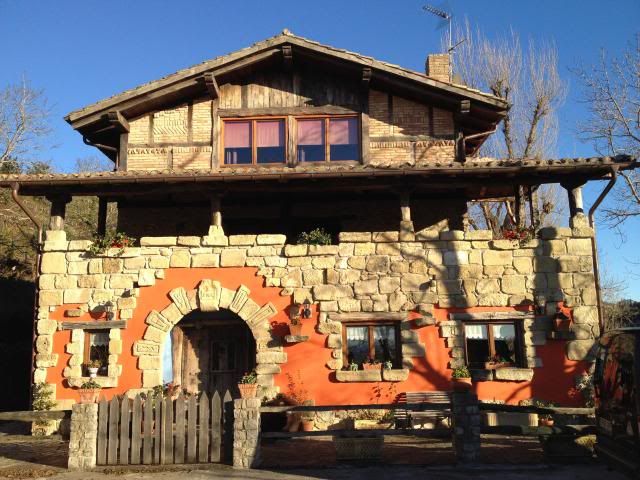

We ate primarily in San Sebastián and had a singular pursuit: to eat as many of the best pinxtos as we could. We skipped the famous Modernist and Michelin-starred spots, mostly since we were traveling on a budget, but also since I tend to prefer the local and more traditional over the cutting edge. One of the lasting impressions, though, was that the pinxto is a canvas for a wide variety of approaches from the simply rustic to the overwrought and fanciful. Thanks to deesher for sharing his intel and pointing our way to a few valuable resources: the encyclopedic Todo Pinxtos website and this Huffington Post list. Trip Advisor proved to be a pretty worthy tool as well.
So without further ado:
A Pinxto Tour of Donostia/San Sebastián
I will detail the key spots shortly, but to begin, a few notes:
Like I said, pinxtos have a endlessly diverse palette, especially the deeper you get into menus. At their most basic they are bar snacks, one or two bites, often served on a cross section of baguette. Worth mentioning is the high quality of bread in this region, perhaps due to their proximity to France. Even in the more economical spots, the bread there was a notch better than anything we ate in Madrid (where we flew in and out of). Most pinxtos that are served directly from the bar are built on rounds of bread, while plates from the kitchen are served with a side portion of baguette.
As you've seen in the posts above, the bars are strewn with dozens of plates of tantalizing little morsels. Our first night in the old quarter of San Sebastián, where there is the greatest density of bars, we prematurely and ravenously ducked into the second bar we saw and totally over-ordered. You don't want to do this: although everything looks amazing, most places specialize in certain dishes. And while even your more homely establishment might put out remarkably high quality products, there is likely a better bite around the corner– the quest is nearly endless.
So, there's all this incredible looking grub right there on the counter for the taking. Once you cross the overly-courteous traveler threshold you get comfortable asking for a plate and helping yourself to this and that. Its pretty remarkable how the bartenders keep track of all the freestyle grabbing of goods. Our next lesson was that the best things you often have to order from the menu– they are prepared in the kitchen. The stuff out on the bar tends to be the simple and the cheap. They may look whimsically dressed up, but there is a pretty basic set of ingredients: jamon (usually the good stuff), Tortilla España, cooked shrimp, sliced octopus, anchovy, peppers- roasted, pickled, and diced and dressed, and a myriad of eggy stuff including the ubiquitous Ensalda Rusa ("Russian" egg salad fortified with potato and ham) as well as sliced hardboiled eggs, preposterous dollops of mayo, and finely grated hard boiled egg (which I thought was shredded co-jack at first, lol). The eggy stuff, in particular, got kinda tedious to me, I've just never been a huge egg salad guy. So, the transcendent bites, more often than not, came from the kitchen and the more sophisticated bars wouldn't even have stuff on the bar at all.
Before we get going, I should note that like many travelers to Spain, we had to readjust our typical eating patterns to fit their schedule. Pinxto bars tend to open for lunch 11-2 but then, like all Spanish businesses, shut their doors at 2 for siesta. The bars, however, won't re-open again until 8, which means you've gotta eat a big lunch or pack snacks for late afternoon. We typically like to enjoy a happy hour on vacation, but this schedule prohibits early evening imbibing, so we'd either drink at the casa or booze at lunch, which proved very siesta-condusive. Some bars don't close in the afternoon at all.
I'll highlight 8 of the most noteworthy of the dozen or so bars we tried. I'll start with the more traditional, transitioning to the more modern:
Taberna Gandarías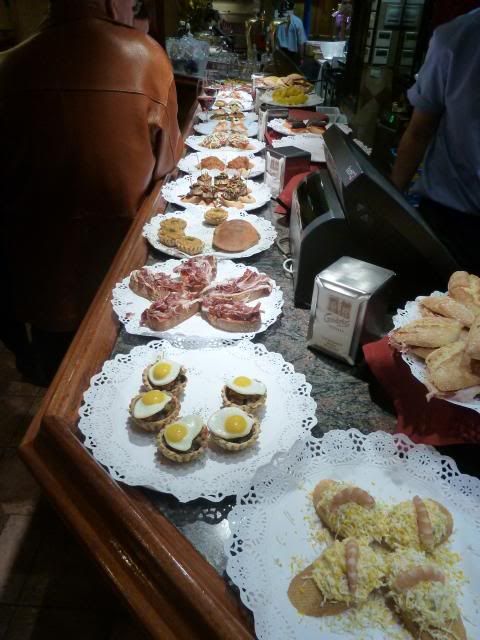
This popular establishment, both a bar and a sit-down restaurant, entices diners with visible-from-the-street cases of pristine fish and primal meat cuts. We landed here a lot in the first few days, since they were open through the afternoon. As you can see above, they have fairly traditional offerings on the bar.
For good measure, here is a shot of their rendition of the ever-present shrimp and ensalada rusa pinxto: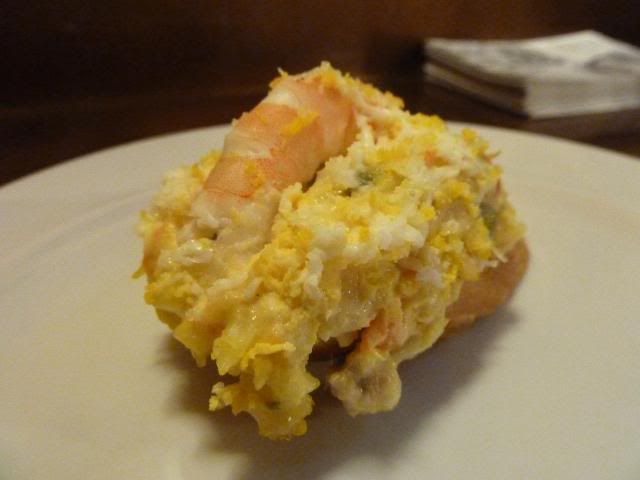
Check out all that oozing eggy goodness. This was the best version of this I sampled.
They are famous for two dishes, both from the kitchen, the first a plate of veal cheeks served in a traditional Rioja-fortified gravy. This dish was tender and comforting, but nowhere near as elevated as versions we had later.
But the Solomillo, or grilled sirloin, on the other hand...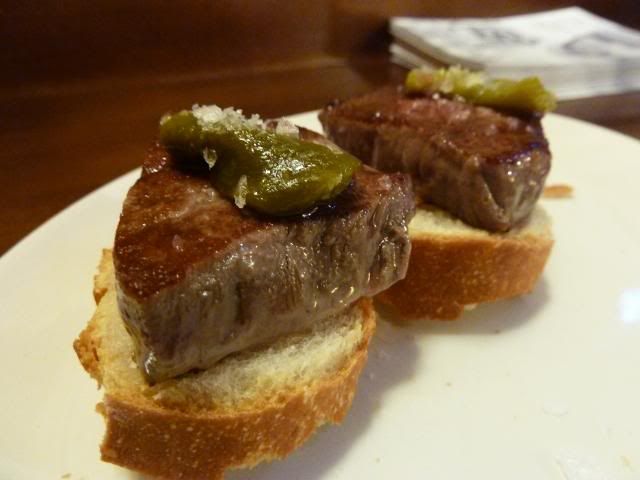
Ideally medium rare nuggets of beefy, minerally steak draped with a roasted pepper with a judicious sprinkling of coarse salt. Perfect. This dead simple bite was a go-to for us.
La Cepa
You can see in my pic and from ronnie's upthread that this place takes its jamón seriously. And thats why we came back, for platters of thinly slice Jamón Ibérico Bellota. Somewhat unorthodoxly, they use a mechanical slicer for the ham and there is something to be said for the melt-in-your-mouth ethereality of this method. I do like a more toothsome hand-cut slice too:
We weren't crazy about their other pinxtos. The over-egging thing again and one bite I had with hard boiled egg had a grey ring, which is a pet peeve of mine. We weren't even that wild about their specialty, Pimiento Relleno: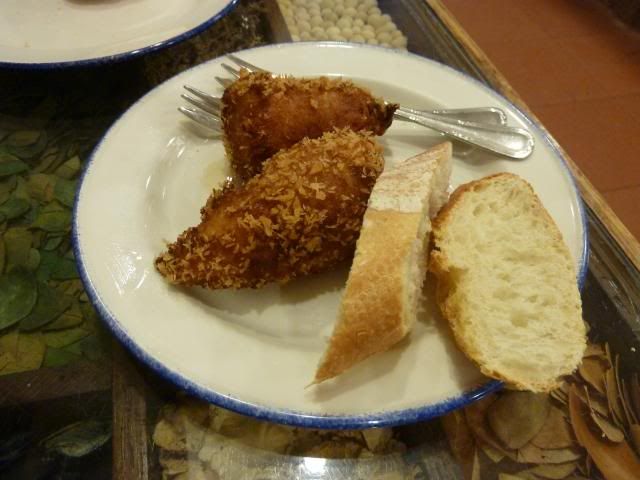
Nice light panko-like breading, but the interior tasted mostly of pasty béchamel with grainy bits of mincemeat, somehow drowning out the pepper flavor.
I was, however, a fan of their Gildas: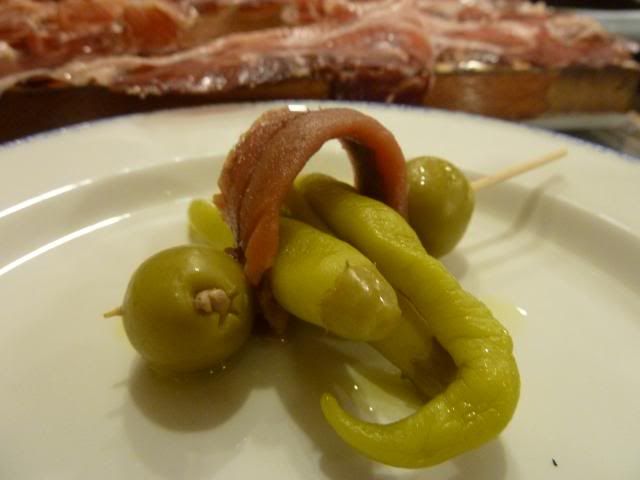
A classic skewer of olive, anchovy, and pickled guindilla chiles which paired nicely with the rich jamón and bright sparkly Txakoli.
Goiz Argi
This bar topped the aforementioned Huff Post list for seafood a la plancha. The grilling here happens on a flattop griddle and while the grill master had a deft hand at perfectly cooking the fishy bits, I was a bit let down that there wasn't open flame involved, since I love some charred up seafood.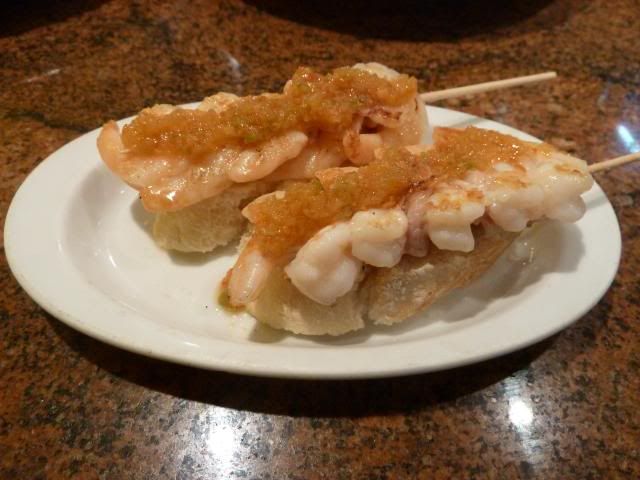
These shrimp kebabs had a nice garlic note and a pepper based salsa cruda.
Though we preferred these buttery chipirones, aka baby squid:
Its worth noting that while we saw piles of crazy fresh looking fish locked in rigor and exotic shellfish like percebes at the market, none of the really premium stuff showed up at the bars. Based on price tags we saw at the market, its clear that the bars have to stick with the basic stuff to maintain a certain price point. That said, it would have been worth splurging on a seafood meal with fresh caught bounty out of the Bay of Biscay. Next time.
My favorite pinxto bar did specialize in one form of premium fish though:
Bar Antonio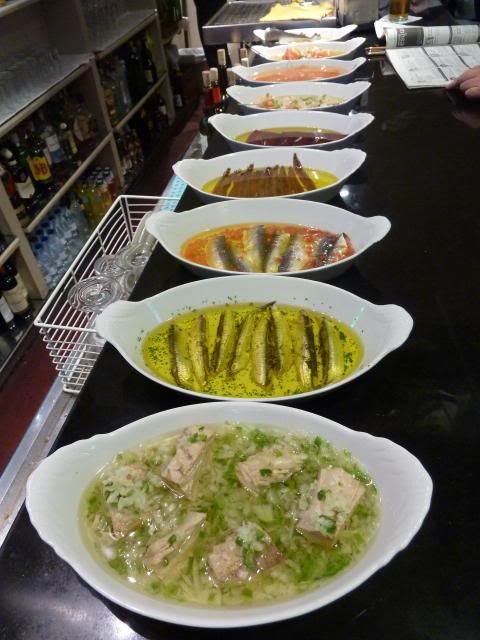
This sleek, but not overly modern feeling narrow bar is not in the old town and had a pretty local vibe. You can peep in that picture above that they specialize in cured fish and man, oh, man they served up a few of my favorite pinxtos.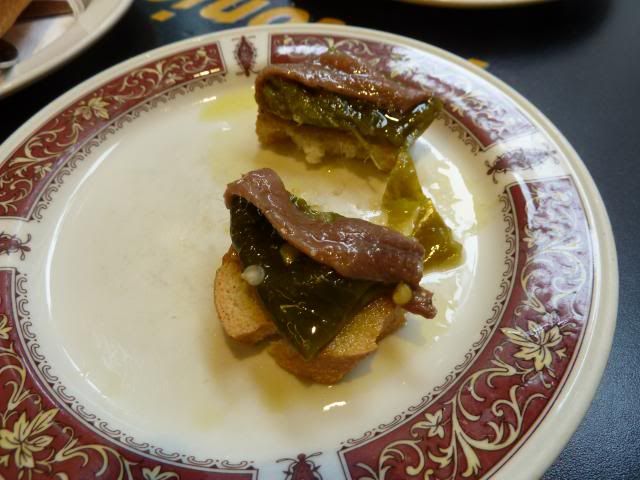
This simple guy was just incredible anchovy and roasted pepper. I found it funny that it was delivered to the table cut in half (none of the other bites were).
Antonio had a flair for plating, check out this thing of beauty: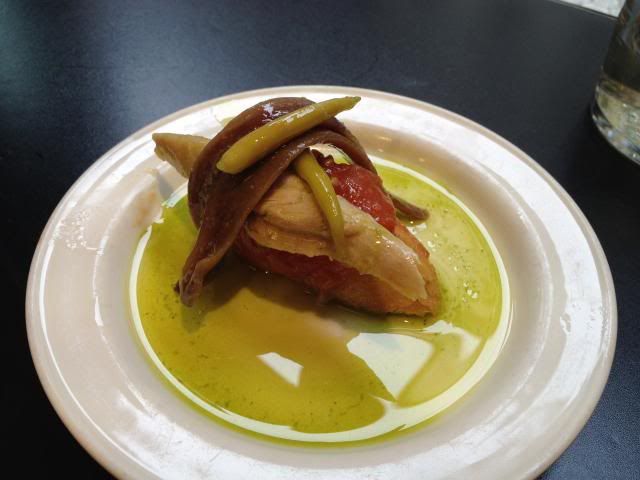
This was probably my favorite pinxto of the trip, I ate 4 or 5 of them by the time we left. Called Igueldo, an elegant construction of oil cured tuna, crushed tomato, same gorgeous anchovy, and guindilla chile served drowned in a grassy green olive oil. Sublime.
One jet lag- hazed morning, I craved something restorative and we found ourselves at Bar Antonio. I ordered the vaguely named caldo de pescado: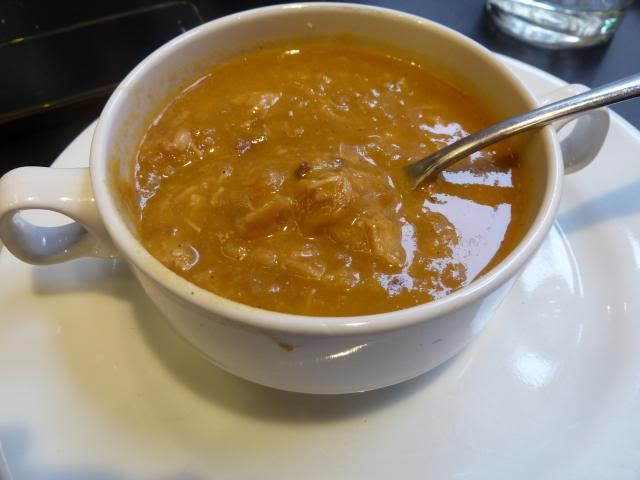
Elemental and exactly what my body was craving, this was a bacalao soup with a peppery note and a rich finish.
I'm a soups and stews guy and was a bit disappointed to not run into more of them. Perhaps its not a big part of the pinxto format. On our last morning I did spy a line up of cazuelas at a touristy bar right on the square.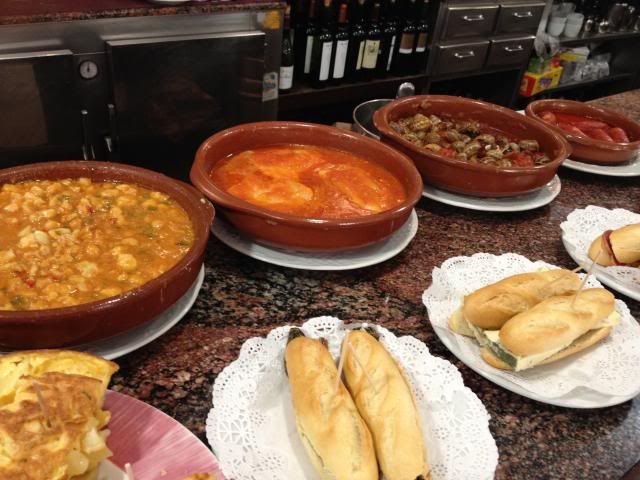
I ordered the bacalao, first from left. It was chunkier and more rustic than the soup I had at Antonio, but had a similar flavor profile, if not saltier.
La Mejillonera
We found that many pinxto bars kinda made up their own hours, which could get frustrating. On our third attempt, this place was finally open at their posted 8 PM opening time. It seemed promising that a small line had formed in anticipation.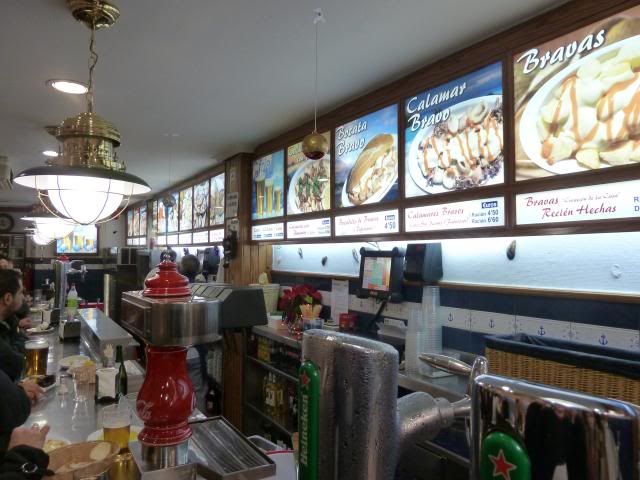
The place was mobbed within 10 minutes, all sorts of local-seeming folks, families, the after work crowd. No bar-top pinxtos here, you ordered from illuminated placards over the bar. They really only offer three things: mussels (their namesake), calamari, and patatas braves all smothered in your choice of sauce. Beers seemed to come in three sizes including a monster liter glass that seemed to be a popular order with the locals.
We started with the calamares with pimientos.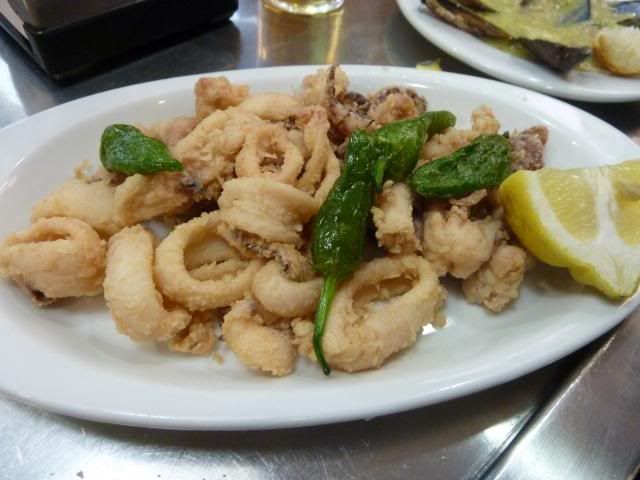
This was a perfectly fine rendition, a good combo with the peppers. Fortunately we had enough sauce to dip in with the next two dishes we ordered:
Patatas Bravas and Mejillones a la Marinerna.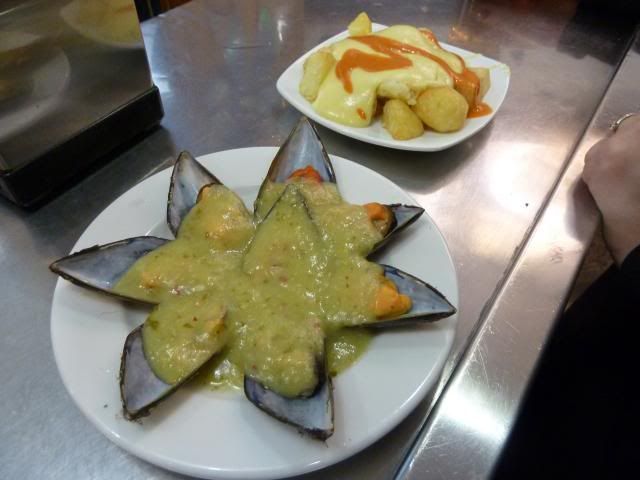
The mussels were plump, but the pools of mayonnaise-like sauce were completely distracting. The patatas suffered a similar fate, logged in viscous goo. That red sauce on top might have actually been the spiciest thing we ate in Spain though. Next time I would order the steamed mussels and forgo the sauce. The whole experience had a fun everyman vibe, but I couldn't help but thinking this was the Basque equivalent of fast food.
La Cucaracha De San Telmo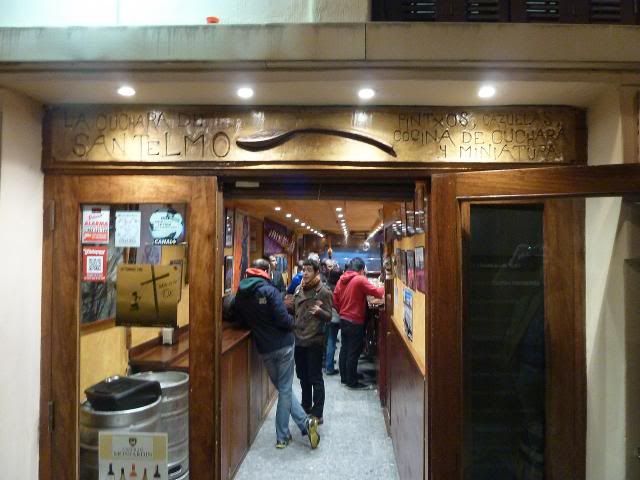
This place had the most erratic hours, closed even during late hours, on certain nights. I will forgive though, because their food was exceptional. This begins our tour of young chef- helmed elevated pinxtos. All ordering is done off the specials board here. One awkward aspect of their ordering process is that you order by twos and with such decadent bites as these, it limits the ordering power. So, regrettably we only found them open once and only tried two things, a shame since the calibre of cooking here was for sure above and beyond the competition.
First, suckling pig: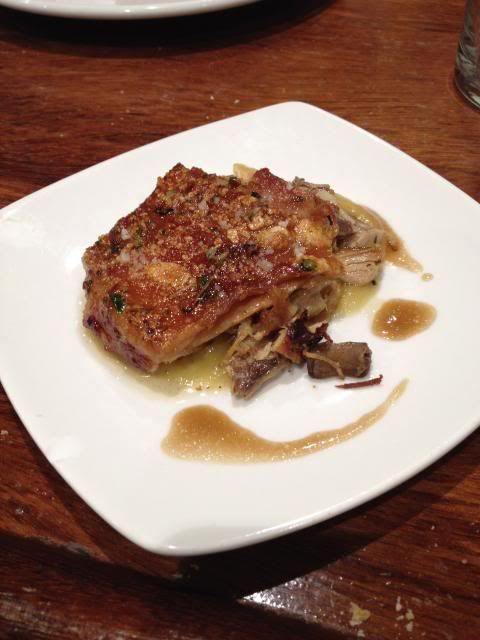
Fork tender, sweet as can be, unctuous meat sheathed in salty good crisp crackling. The apple compote smear was an afterthought, this meat was so good.
Then braised rabbit shank with porcini: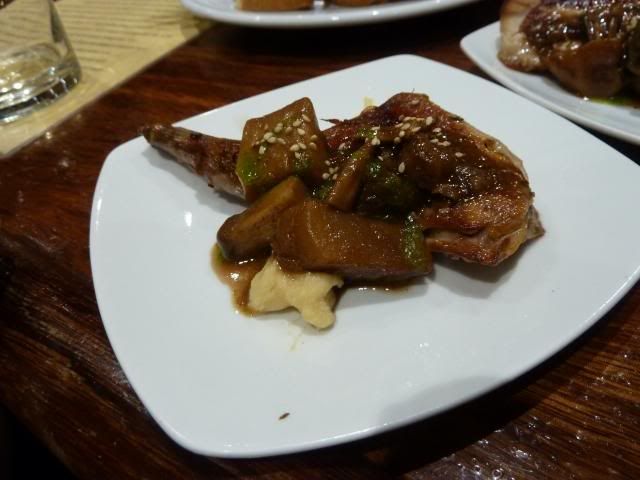
This picture does not do this work of art justice. Though I must remark that this place seemed all about perfect ingredients cooked to perfection without any of the overly dressed-up eccentricity that lesser hands cloaked their product in. This dish was spectacular, rabbit cooked as tender as the pork on the previous plate in a gorgeous demi-glace and a not-skimpy-at-all count of delicate porcinis all drizzled with an herbaceous salsa verde. This is the type of cooking that I think many of my favorite restaurants strive for– an unfussy reverence for exceptional ingredients.
Borda Berri
This popular spot had a similar feel as La Cucaracha– it had a hip late night vibe and was absolutely packed on our two visits. The pinxtos here are ordered off a nightly chalkboard menu and their approach is similar to La Cucaracha, chef-driven small plates made with choice ingredients.
They are famous for their veal cheek: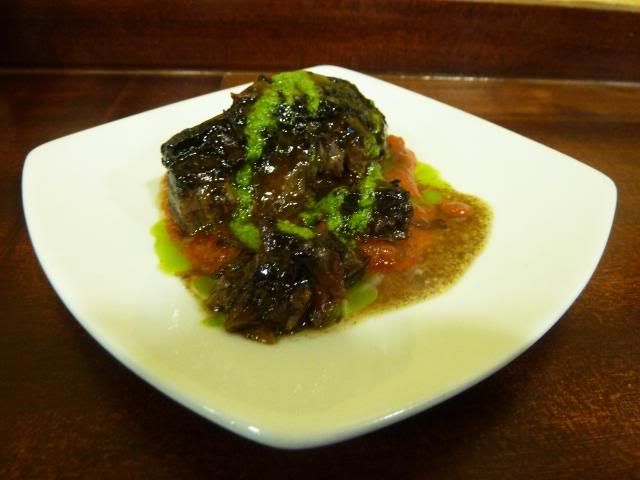
This was at the top of our list of favorites. The meat was braised tender, though seemed to be blasted with heat to crisp up the edges (not unlike birria tatemada). Served in its wine-based braising liquor and then topped with a tomato sauce and a salsa verde, the flavors on this guy were pretty huge with an unapologetic saltiness. All that jus mopped up with fine baguette sent this one home.
Some of their presentations skewed fanciful: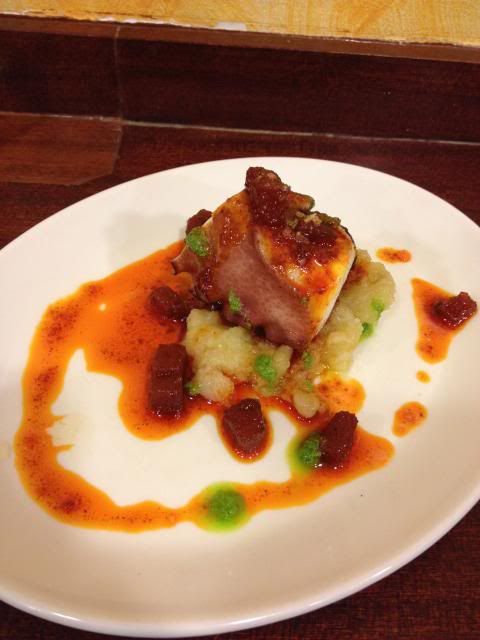
Like this psychedelic dish of octopus served atop polenta, strewn with cubes of quince paste, and drizzled in a pimentón spiked olive oil. Unfortunately this one did not come together so well. I'm not a fan of quince in general and its cloying sweetness did not match well with the smoky oil. Though I had less issue than my lady with the cut of the octopus, this was a huge freakin hunk of tentacle which was cooked very tender, though like an unpeeled lengua, had a textural range from springy to gelatinous.
This recommended dish looked unassuming but was very rich: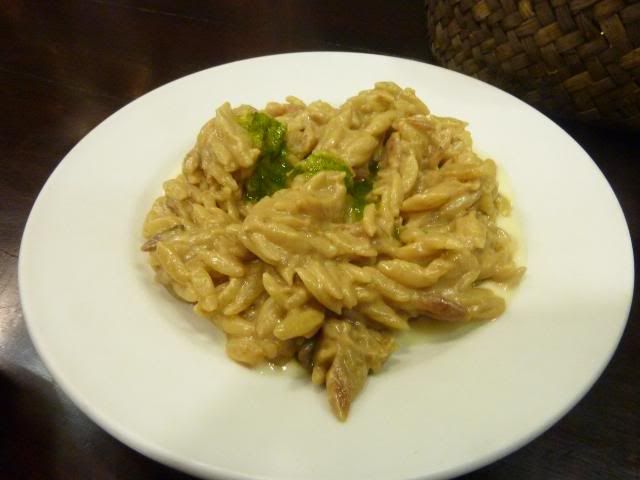
Basque risotto is made with orzo apparently. It was as creamy as could be with umami all over the place from funky idiazabal cheese and sautéed porcinis. Good stuff.
The elbow-to-elbow surroundings and low light made it pretty hard to snap pics in this place, so not pictured was an excellent dish called "pork kebab" which was a very generous portion of once again, meltingly tender braised pork, not unlike their neighbor's suckling pig. Like all the bites at Borda Berri, this had big time flavor with an oily curry note. Also worth noting is that just about every diner here ordered their foie dish, which is popular on many menus in San Sebastián, which looked delicious, but we are not the biggest fans. Theres good reason why this bar is packed nightly.
A Fuego Negro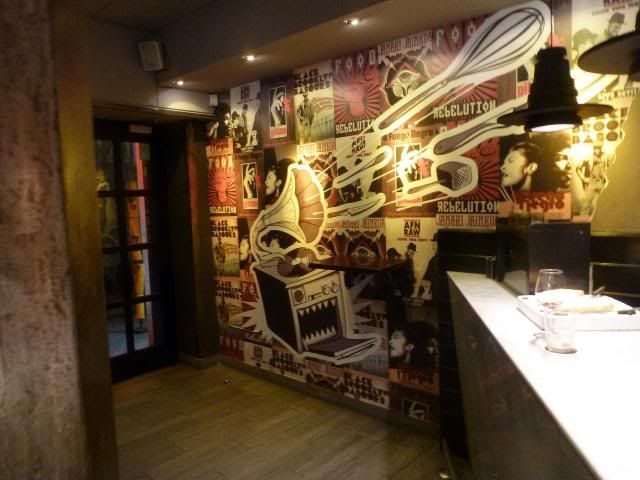
And lastly, a stop at the most decidedly new school of the pinxto bars we visited. As you can see by the detail of the decor above, this place has a hip, nuevo vibe– lots of tatted-up chef-itude– a punk look, though a hiphop en español & reggae soundtrack. It looks like a record shop or an indie comix joint with prominently displayed house merch. I picked up one of three cookbooks, which included a pretty sweet mix cd, each song corresponding to a recipe. You get the picture, hipster pinxtos.
The menu read in a linguistic mash up of Basque, Spanish, and English, cute but not entirely legible. Many of the dishes reflected an ironic take on pop cuisine, such as their signature Makcobe with txips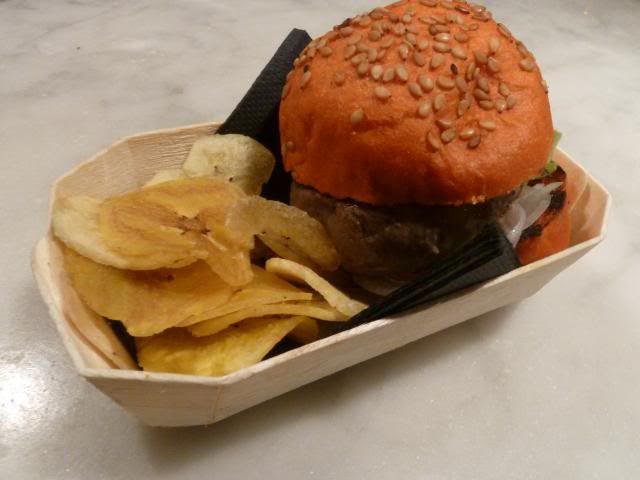
Not a great shot of not-my-favorite dish. We had avoided the passé-to-us Kobe slider on menus all around town, but this seemed like its native environment. There was good beef in there, cooked bloody and full flavored like all the meat we ate on this trip. That bun though, it looked like an orange macarón and had a cold, slightly stale texture. The "txips" were fried coins of plantain, not unlike a bag of Goya product I can pick up at my local liquor store.
To balance out the kitsch, we ordered a more "serious" dish. Coaled cod with pepper pips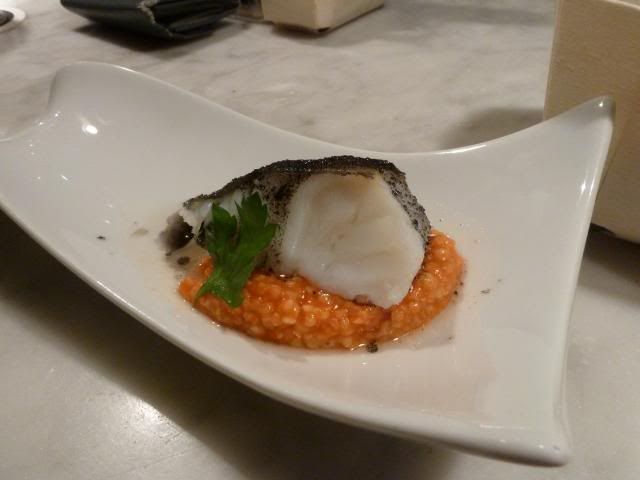
Not a bad dish, though aside from an ashy surface, it was hard to discern what was "coaled" about the cod. And "pepper pips" were certainly more tasty than bitter pepper seeds– to my palate it seemed to be very coarse ground polenta suspended in a peppery sauce.
A Fuego Negro is a fun place to have a drink and people watch. The staff are very cool. For my money though, I'd stick to the elevated plates at La Cucaracha and Borda Berri if you are looking to sample the vanguard of the pinxto scene. Maybe its just my conservative tastes, but the best pinxtos tended to be the most straightforward in both execution and presentation. This focused approach to highlighting the best ingredients is always what has made Spanish cuisine one my most esteemed.
On the other hand, you can find a piece of ham with some parmesan crisps at a food stall at the market that looks like this:
There is a novelty to the tweezed-out stacking and drizzling of the undoubtedly Modernist influence on the simple drinking snack format. And in the case of spots like Bar Antonio, a certain stylishness adds to the experience of the dishes. All said, its a hell of a lot of fun that you can sample such a wide range of cuisine in such a compact urban area, which is what makes a trip here so essential to the discerning eater. I'm sure Arzak and Mugaritz are lovely, but for a fraction of the price, you can sample hundreds of creative bites made with the finest ingredients at the pinxto bars.
As mind-blowing as our pinxto tour was, my favorite overall eating experience of the trip was in Astigarraga, which I'll post about here soon.
Taberna Ganarías
31 de Agosto Kalea, 23
La Cepa
31 de Agosto Kalea, 7
Goiz Argi
Femin Calbeton Kalea, 4
Bar Antonio
Bergara Kalea, 3
La Mejillonera
Puerto Kalea, 15
La Cucaracha de San Telmo
31 de Agosto Kalea, 28
Borda Berri
Fermin Calbeton Kalea, 12
A Fuego Negro
31 de Agosto Kalea, 31
-
-
Post #62 - January 15th, 2014, 2:44 pmGreat stuff, Jefe. Thanks for sharing. And congratulations on your marriage!-Mary
-
-
Post #63 - January 15th, 2014, 4:38 pmOh baby--what a trip! May your marriage be as delicious and delightful as the honeymoon
 !!!
"Knowledge is knowing a tomato is a fruit; wisdom is not putting it in a fruit salad." Miles Kington
!!!
"Knowledge is knowing a tomato is a fruit; wisdom is not putting it in a fruit salad." Miles Kington
-
-
Post #64 - January 17th, 2014, 6:50 am

Your mouth-watering shots from Bar Antonio are absolutely stunning. Looking at them, the typical Spanish culinary philosophy of presenting, first and foremost, a pristine product minimally prepared (i.e. letting the product speak for itself) is clearly illustrated.Jefe wrote: Maybe its just my conservative tastes, but the best pinxtos tended to be the most straightforward in both execution and presentation. This focused approach to highlighting the best ingredients is always what has made Spanish cuisine one my most esteemed.
As my old-school Spanish buddies often say in jest (but I know they're completely serious) "Tradition...it's there because it works!!!"
Thanks for sharing, Jefe.
-
-
Post #65 - January 23rd, 2014, 4:40 pmWhile the pinxto tour provided so many of my favorite bites on our trip, as I alluded to upthread, the most memorable meal I ate in Basque Country was right down the road from our casa in Astigarraga (and just on the other side of the mountain from Mugaritz).
Petritegi Tolare Sagardotegia
A Cider House Feast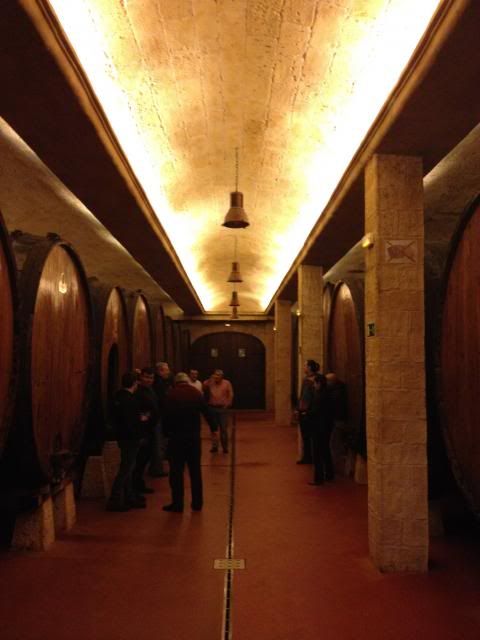
Let's start with the cider…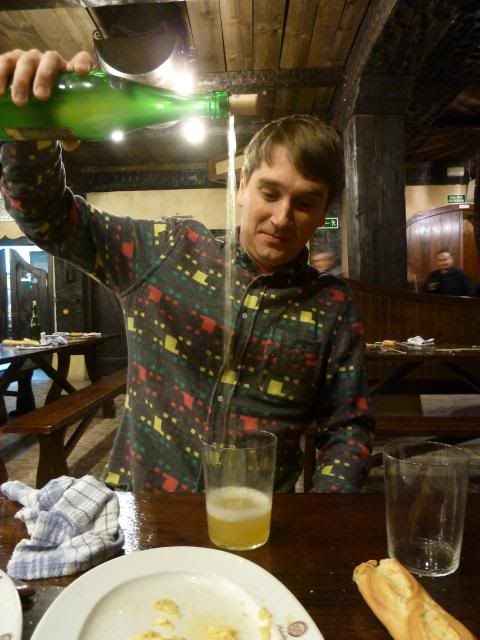
Despite my confident pouring skills, I am no cider expert. I like it and tend to order it a lot more these days when I'm out thanks to upstart local craft cider producers like Virtue. Storied for their cider, I knew I'd have to get into it in Basque Country and I had my first pour at a pinxto bar in San Sebastián. Subsequent glasses I sampled tended to have similar qualities– very sour with a yeastiness not unlike Belgian sour beers with a cloudy translucency. Unlike other ciders that I am familiar with, Basque cider is very lightly conditioned. And similar to the pouring technique for the semi-sparkling white wine Txakoli, the Basque have a particular method of maximizing the fizz in their cider: the high pour.
At our lovely farmhouse, while the family was off at work or school, their ever-so-gracious grandmother watched the casa. She spoke no English, but my high school Spanish was adequate enough for us to keep conversation. And when I asked her what she would recommend for us to do in Astigarraga, without hesitation, she mentioned Petritegi. We would not argue. While there are several and perhaps better sidrerias in town, this epically cavernous drinking hall– they can seat 700!– seemed to be the go-to of locals and visitors alike. Guests are seated communally at long, old wooden tables and immediately served a 750 mL bottle of house cider and a several-foot long baguette. We were seated next to a double date of elderly Euskadi speakers and at first I didn't reckon we would have to much interaction…
We kept to ourselves for the first two courses, which we ravenously devoured before I could snap pics. The first course were two little greasy nuggets of an almost Mexican-like fresh chorizo, snappy and wonderful. Things would just keep getting better from here– next we inhaled a jiggly omelet loosely encasing silky, salty bacalao, a work of art. Sated, I began to more astutely pay attention to my surroundings, in particular, what the cheeky old dudes sitting next to us were up to. I noticed that there was no bottle on their table and every five to ten minutes or so they would get up and return with full glasses. I caught the mischievous eye of the geezer sitting closest to me across the table and he gave me an enabling grin, tapped on his empty glass, and motioned for me to follow him.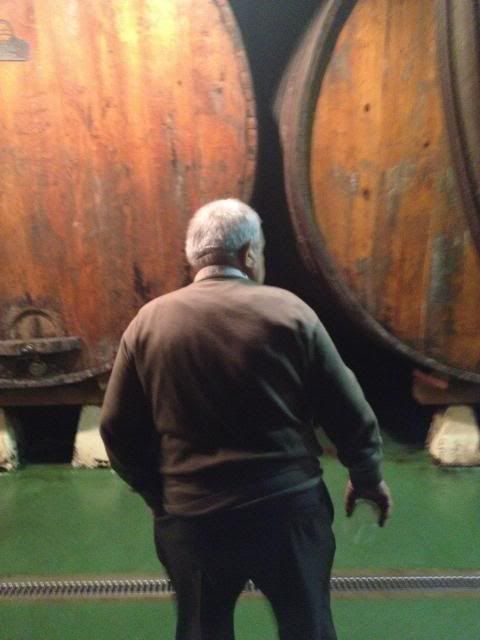
The cellars, lined with towering wooden casks, were filled with chuckling bands of merrymakers. Certain vintages were tapped and completely available to trot right up to and fill your glass. Like the from-the-bottle high pour, there is a very specific method of topping off: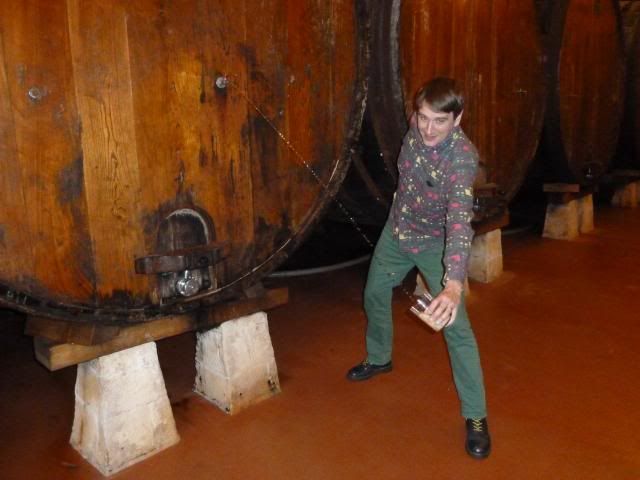
You open the tap, somewhat nonchalantly letting the stream spill into a drainage system on the floor, then duck down as low as you can to maximize the distance between glass and stream. I was instructed that it should always be caught on the side of the glass at about 30°. I can't tell you how many barrels we sampled, but the range of favors was pretty remarkable, funky, musty ones to brighter apple-y ones. As soon as my glass was looking low, there was my new buddy with that naughty gaze and a tap on the glass to rush back for a refill. Too much fun.
The next two courses were something else:
Nuggets of perfectly fried, sweet-fleshed merluza were adorned with a confit-like melange of crispy, caramelized onions and sweet chiles. In some ways this dish reminded me of a few of my favorite fish preps in Chinatown, though more elemental. This was an absolute favorite of the whole trip.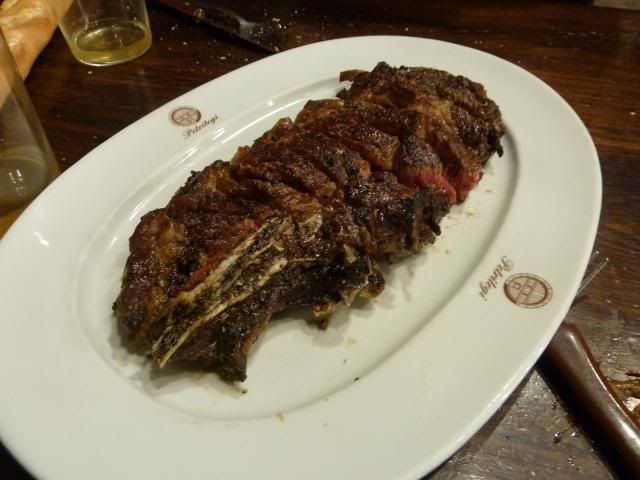
My wife, a steak fiend, declared this Flinstonian t-bone the best steak she's ever ate. It was damn good, you could taste the love in the sweet, slightly funky fat. We demolished this.
Another funny interaction with my new buddy, who spoke no Spanish, only Euskadi and French, was his poking fun at the much more substantial pile of crumbs in front of his plate than mine. This dude was putting the baguettes away! I loved this aspect of dining here– it was okay to make a mess and not repress one's joie de vivre. (I think we've got some pretty puritanical dining habits on this side of the pond). Everybody was getting crumbs everywhere and tossing their napkins on the floor (a custom throughout Spain). Unbridled laughter, hugging strangers, in fact, it felt like everything went at this place, like one of those Renaissance paintings of village folks getting housed over a feast at the local pub.
Dessert was as simple as fresh walnuts, and man were they fresh, in the shell served alongside funky, sheepy local cheese, and quince paste. Of course, it was totally cool to let the shells fly everywhere.
This was a meal of a lifetime. I got drunk, made friends, ate some of the simplest, finest food that I ever have. And oh yeah, all this cost 28€!
Petritegi Bidea, 20115 Astigarraga, Gipuzkoa, Spain
-
-
Post #66 - January 24th, 2014, 4:52 amMan.... What a great trip, congrats. Also thanks for sharing.
Photos definitely captured the fun and food.
-
-
Post #67 - January 24th, 2014, 8:57 amJefe-
Fantastic photos and description. Sounds like a blast! Thanks so much for posting.-Mary
-
-
Post #68 - June 19th, 2014, 1:47 pmI spent 18 days in Spain on what was mostly a pleasure based trip. This meant lots of food and drink thus San Sebastián was a must. Spent five days in the beautiful seaside town and ate as good as I ever have without stopping in at any of the Michelin spots. I got nothing against the Fat French Tireman and even had reservations for two places but we canceled them for the love of pinxtos. Unfortunately it would take months to upload and copy and paste all the pictures from the entire trip but I'll share important tidbits here and there. Feel free to check my complete San Sebastián report with almost everything we ate and please enjoy this tip listage that I'm previewing here today. No doubt about it San Sebastian was the highlight as far as food goes from the four stops we made traveling thru Spain (Madrid, Seville, San Sebastián, Barcelona). So without further ado my top ten pinxtos I ate while in San Sebastián.

Donostia
________________________________________________________________________________
10) Battered Prawns from Tamboril
In a word: Satisfying
Notes: I munched on these while we bar hopped during the Real Madrid vs Athletico Champions League Final. They're fried to order and come with three prawns inside the airy almost dessert like dough. They were the perfect snack paired with a beer and are one of the favorites of the locals and also
________________________________________________________________________________
9) Arroz Del Dia from Atari
In a word: Comforting
Notes: This hopping spot by the church in Olde Towne was packed on each of our visits. They have pinxtos on the bar as well as hot ones made to order. You can also get half and full portion plates and they make a handful of different gin and tonics and have a nice patio with outdoor seating along one side. The rice of the day can be ordered as a pinxto or full serving and whichever one you choose it will really hit the spot. On this day they had a deep chicken broth with crisped up jamon and roasted cherry tomatoes on top. Due to the fact it was raining and only about 50 degrees out this really hit the spot.
________________________________________________________________________________
8) Txangurro (Rock Crab) from Ganbara
In a word: Savory
Notes: On our first night in town we had a pinxtos tour of the Olde Towne area booked and this was one of a few stops from it with an item that made my list. Our tour guide Eli (pronounced Elly) was fantastic and brought us here for their signature pinxto which is basically a Basque version of a crab cake. We found ourselves stopping in for one, amongst hordes of other people, on more than one occasion. I'd encourage everyone visiting to take the tour with San Sebastian Food as there's so many stops in town that they switch it up often and you eat and drink the price of the ticket while getting a locals scoop of what to order, not just at the places you visit but also the spots you pass. Not to mention the different people from around the globe you'll meet on the tour.
________________________________________________________________________________
7) Stuffed Asparagus from Bar Iturrioz
In a word: Delectable
Notes: The specialty of the house at this bar located amongst the shopping center is this pinxto made with white asparagus wrapped in jamon and cheese thats then coated in batter and fried to order. I tried not to eat too many of the same things knowing I could always come back but I had three of these in one sitting and talked myself out of getting a fourth. It's been hard going back to normal stuff like onion rings.
________________________________________________________________________________
6) Sirloin Steak (Solomillo) from Gandarias
In a word: Juicy
Notes: Another stop from the food tour where they did special things with beef and mushrooms. Nothing fancy here just sirloin steak grilled to a perfect rare that gets topped with a roasted pimento pepper and some chunky sea salt on top a piece of bread. You need to eat this one fast because the bread can only hold up to so much of the juice seeping out of the meat. There would be multiple stops for this.
________________________________________________________________________________
5) La Hoguera (The Bonfire) at Zeruko
In a word: Daring
Notes: This gastronomic pinxto bar took my breath away. The selection process was insanely overwhelming. They had literally 100's of selections that extended from one end of the bar to the other. This is another example of why you need to get on the food tour and not only enjoy the selections they serve you but also ask them what else is good at each of the spots you visit. In the case of Bar Zeruko it's all good. However one must get is this magnificent setup called 'the Bonfire'. It comes served on a small casserole topped with a metallic grid. Below is a piece of charcoal with some rosemary atop it. You grill the piece of half smoked cod to your liking and put it on the bread that comes with a tasty creamy onion and parsley sauce. To finish you shoot the asparagus juice in the test tube. A delicious and also very engaging pinxto.
________________________________________________________________________________
4) Prawn with Bacon Skewer at Goiz Argi
In a word: Addicting
Notes: Yet another one of the spots Eli and the San Sebastian Food tour brought us too this was actually our first stop of the trip and ended up being our most visited bar by far. The prawn skewer with bacon topped with an amazing hot (in temp) salsa like concoction was literally lick your fingers good. We must of been in here for one or two on at least six occasions.
________________________________________________________________________________
3) Duck Confit Ravioli from La Cuchara De San Telmo
In a word: Marvelous
Notes: Truth be told any of the things I ate at this place could of made this list but I chose to only include one pinxto from each spot. This was my favorite place to eat and I went thru most of the menu on my three visits. Check da ole blog to see all of it but the major highlight was probably this duck confit ravioli that was just brilliant. Everything is made to order here and most of the pinxtos which come listed on a chalkboard are around $4/5 Euros. I thought it was a steal, hell the whole town is as far as these pinxto bars go. The ladies in the kitchen need a Michelin sign on their wall. I'll be back here on day one of my return to town.
________________________________________________________________________________
2) Urola from Casa Urola
In a word: Refreshing
Notes: This place was a close second as far as my favorite places to eat goes. It doubles as a sit-down restaurant and we were tempted to go upstairs but the items on offer downstairs were just to damn good to pass up. They have a selection of ready to eat options as well as some hot ones and specials for the day on a chalkboard. I actually ordered this accidentally when thinking their scallop pinxto (Vieira) was the 'Urola' which is the first one listed. As good as the scallop in cream option is I was glad to be wrong. Described as "cuchara de salpicón de bogavante fresco" on the menu this was the best damn lobster salad you'll ever take a bite of.
________________________________________________________________________________
1) Foie Gras ala Plancha from Bar Alex
In a word: Grand
Notes: Located the opposite way of the main shopping and bar hopping district (San Sebastian is pretty small) was this locally loved bar. All of these places were great but the service here was top notch and came with a laughing smile each time I returned for this plate. The foie gras ala plancha with a salsa de cebolla y naranja and pecans was something that made me want to stop in each morning before doing anything else after my first time trying it. If I could eat this everyday I'd die a young and happy man.
________________________________________________________________________________
Bonus Tip: Daytip to Getaria

Getaria, Spain
When doing some research on where to eat out I came across a little article about this fishing village where many people say the best seafood restaurants in the world reside at. San Sebastian is and was a fishing community at heart but like Jefe mentioned upthread there aren't a ton of seafood centric spots in town. With it's growth some fisherman have moved elsewhere along the coast. One of these spots is the pretty little town of Getaria. It's only about a 40 minute bus-ride from the heart of San Sebastian and the only reason it's over 20 minutes is because of all the stops in the other towns it makes on the way up. It's also got a couple different beaches open to the public and a big surfing community as well as a nice business strip in the center of town right where the bus drops you off at.

Beautiful Waterfront Community
When you start trekking down the street where all the action is taking place you notice that all the restaurants have charcoal grills with fish on them. There must be 10+ spots doing this and at first it looked as though our luck wasn't going to be good because most of the restaurants were telling us they were "Completo" aka booked.


Wonderful Smells from all over
Taberna Politena
I managed to speak in broken Spanish to the bartender at this place pictured below which caught our eye due to the fact it was packed and the grillman was busy. I explained we wanted some pescado asado and we were sitting outside at the free for all tables. They were extra helpful and happy to have us in despite the fact lunch service would be ending and everyone would be clearing out within a half hour.
Locals Spot in Getaria
I started off with a couple pinxtos from the bar upon ordering our drinks. I asked for this fish sliver one I saw as well as their "especialidad de la casa" and was given one with a mushroom wrapped in jamon that was deep fried. Fantastic.
Pinxtos to Start
The friendly waitress who knew decent English helped us order by explaining if we got the menu of the day we'd save a few dollars. It was your choice of grilled fish along with an appetizer, we chose grilled prawns, and also a desert choice and even a glass of wine. Cheap as most things made in China this was also one of the best meals of the entire Spain trip. The gambas were so good we had to order more. We also had to have more bread to soak up all the juices they were releasing and I'll remember that piece of fish for a long time.
Grilled Prawns
Whole Grilled Fish
________________________________________________________________________________
Read more about this trip HERE.
-
-
Post #69 - June 20th, 2014, 7:37 amDamn, Beef, you went HAM!
Needless to say, Donostia is one of the best places to eat anywhere. Even though I was there just over half a year ago, this post makes me feel absolutely covetous and know that I will indulge once again on those cobbled narrow streets.
I am especially dying to get back to La Cucaracha, since we only got one hit in. Truly world class cuisine. One q– somehow when we ordered they brought out two of each plate. Perhaps a language mix-up, though I found them to be one of the more English- friendly establishments (then again, I may have been flexing my questionable en Español skills on that particular eve).
Gotta love that solomillo at Gondarias, which was my wife's favorite of the trip. A true display of the brilliant simplicity of Spanish cooking, letting the ingredients speak for themselves.
Topa!
-
-
Post #70 - June 20th, 2014, 8:37 amprobably the most mouthwatering thread on this board
-
-
Post #71 - June 20th, 2014, 10:26 amBeef Scores Again! I think he must have the record for successive hits without a miss...
Keep travellin', chowin', and scribblin' Beef! We'll all be waiting.
GeoSooo, you like wine and are looking for something good to read? Maybe *this* will do the trick!
-
-
Post #72 - June 20th, 2014, 11:36 amAlekH wrote:probably the most mouthwatering thread on this board
Makes sense because it's one of the very best regions in the world to eat.
Great stuff, Titus! It really makes me want to go back . . . now!!
=R=By protecting others, you save yourself. If you only think of yourself, you'll only destroy yourself. --Kambei Shimada
Every human interaction is an opportunity for disappointment --RS
There's a horse loose in a hospital --JM
That don't impress me much --Shania Twain
-
-
Post #73 - June 20th, 2014, 5:19 pmThis pisses me off. I have a family Euro trip coming up. I was pushing for the Basque origin of my Cuban in-laws and myriad friendly Tampa Cubans and Spaniards of my youth. Ya'll will have to suffer through a Munich/Prague thread instead later this summer. Incredible stuff as always, whether it's stew in Indy or prawns and foie gras on the Cote Basque.
-
-
Post #74 - July 31st, 2015, 12:41 pmI recently had the fortune of taking a 10-day trip to Spain with a longtime buddy of mine. Being forever busy as a software macher, he put me completely in charge of deciding what would be our route as well as choosing any restaurant to my heart’s desire.
I enjoyed spending the prior three months carefully studying, then titrating every restaurant and town we would potentially visit. We ultimately decided to spend the first two nights in Madrid, make our way north to The Basque Country for six days with a one-night stop in the town of Soria (home of the world’s largest truffiere or truffle orchard/ Spain’s main truffle-producing areas), then return to Madrid for our flight home.
Since most of our restaurant selections typically would entail multi-course meals, we thought it made most sense to have these primary debaucheries as a lunch – especially since the Spanish typically start eating their midday meal around 2-3pm and dinners surely no earlier than 9:30pm.
***
Asturianos (Madrid)
We came across a wonderful NY Times article titled ”Where Madrid Chefs Go for ‘Real’ Spanish Food” which led us to two outstanding family-owned restaurants there – Asturianos and Sacha, the latter of which we hit up on our return to Madrid.
Asturianos is a small, cozy family-run restaurant in a completely nondescript part of Madrid. The cooking is predominantly done by an Asturian grandma with the FOS run by her two sons. One of them spoke perfect English, having spent some years in Manhattan, and insisted on putting us completely in his hands, of which we agreed. It turned out to be of the smartest moves we made on the trip.
These marinated sardines set in olive oil and tomato concasse were the best of the trip. Having no reference point since we enjoyed them on day #2, they turned out to be the best sardines and some of the finest fish we ate on the entire trip. A simple preparation yet amazing. I love how the Spanish will typically compartmentalize their dishes, serving things on their own without accompaniments or side dishes.
Lightly salted and coarsely shaven bacalao ensalada

For a finale, we luckily were led to mama’s Fabada Asturiana, the signature dish of the province of Asturias. Made with Asturian fabes (beans), chorizo, morcilla (blood sausage), and cured pork, this bean dish was lusciously creamy and pleasantly fatty. Besides trixie-pea’s cassoulet, I’ve never had a better bean dish anywhere. Fabada Asturiana is definitely something worth seeking out if you have the chance while in Spain.
This place is a real gem and shouldn’t be missed while in Madrid, especially if your preference is to eat at small, homey places where splendid, traditionally prepared dishes are always served.
*
We decided to make a one-night stop on our northerly trip towards the Basque Country in the town of Soria. Although neither one of us had a clue about Soria going into the trip, serendipity paid off in spades. Located off the Duero River, Soria has numerous medieval churches and ruins and seemed to be visited mostly by Spanish tourists in relatively few numbers. If you visit Soria, I would highly recommend staying at the modern Parador which is built on an old castle mount and has breathtaking views overlooking the entire area. The accomodations are first-rate.
It’s worth noting that most hotels we stayed at included an outstanding breakfast buffet, often times serving multiple styles of eggs, tortilla de patatas (wild mushroom as well as plain), an assortment of cured meats such as jamon, chorizo, morcilla, and even nduja, cheeses, fruits, cereals, freshly squeezed juices, and breads. Although virtually every hotel breakfast we had on the trip was a total treat and always started our day off on the right foot, the one at the Soria Parador was the shining star.
Fogon del Salvador (Soria)

Having arrived for lunch slightly on the later side (around 3:45-ish), we seemed to be a bit under the gun to order from our pleasant but anxious server. I quickly ordered something off the menu that I was completely unfamiliar with - Spanish migas. Like other forms of migas, it historically is a peasant food made with yesterday’s bread (or tortillas in the case for Tex-Mex versions) that is cooked with pork fat, water, garlic, and paprika. In this region of Spain, it is typically topped with grapes.
While taking a lovely post-lunch cigar walk around town after lunch, I contacted my long-time Spanish friend, “The Senator”, and asked him if he was familiar with the Spanish rendition of migas. He just started laughing. As it turns out, migas was his father’s favorite dish from youth (Mariano lived through the Spanish civil war as a child in a small village south of Zaragoza called Montalban) and he would force The Senator and his siblings to eat as well as respect the stuff growing up.
I thought it somewhat resembled my paternal Ashkenazi grandmother’s Sabbath kishke!

On a sidenote, a dish that should absolutely be sought out when visiting Spain is cochinillo asado or roasted suckling pig. I was initially turned on to this dish by The Senator when we did a month-long road trip together back in the 80s. The first place I enjoyed this dish was in Salamanca where the restaurant had a real piglet in the display case next to the entrance of the restaurant - with a cigarette hanging out of its mouth. From what I pick up, many Spaniards relish a morbid sense of humor.
The suckling pig at Fogon del Salvador was the shining star and some of the tastiest pig I’ve eaten anywhere. It was ideally salted, bringing out the true qualities of this luscious meat. The pig skin was uniformly crisped to perfection as well.
*
The next day, we made our way to the highly-routed Asador Etxebarri. I won’t bore you with more praise of this culinary temple as both tatterdemalion and Ronald Suburban have already accurately and beautifully provided its fully deserving accolades. The only thing I’d really like to add is that their exquisite minimalist approach with handling of the top-grade product they are procuring was almost Japanese-like (keiseki) in philosophy. Besides Urasawa in Los Angeles, no restaurant has ever resonated more with me than Asador Etxebarri. I should add that I’ve never been to a restaurant that did a better job of matching the food with a beverage pairing menu. All drinks were regional - sparkling rose, Txakoli, Sidra, beer, a red wine from Rioja, and a fortified wine) and perfectly enhanced the dish at hand. If you’re willing to spend ~200 Euros for the tasting menu with wine pairings, you will be forever rewarded. Its places like this and the master chefs behind it that have the potential to change the way one perceives food at the highest levels. Like Urasawa, I look at Etxabarri as one of the world’s great culinary temples, not just simply another excellent restaurant.
*
Elkano (Getaria)
The view as you walk into Elkano
Continuing eastward along the stunning Basque coast, we stopped in the lovely town of Mutriku for a morning tidepool excursion, then for a much-anticipated lunch in the coastal town of Getaria. As Da Beef nicely describes above, Getaria is known for its numerous local live coal whole fish restaurants…with turbot being the featured there. We opted to try the highly-touted restaurant Elkano, where we highly enjoyed grandma’s fish consommé (outstanding fish essence with a pleasant background note of mushroom. However, they claim that mushrooms are not included in the recipe.), grilled hake (merluza) cheeks or Kokotxas a la parrilla, and the grilled turbot. Classic Spanish presentation and a truly lovely lunch that was followed up with a tremendous cigar walk (Partagas Series E) around Getaria and its impressively tranquil fishing harbor. My love for cigars came from The Senator’s father, who always insisted that a cigar was to enjoyed after a lovely meal at their home during sobremesa along with an espresso and a spirit of your choice (He always called it the “trilogy”!). I enjoyed a cigar after every lunch we had while in Spain and have to admit that it was always the pinnacle of my days there, giving a sense of serene closure to many lovely meals.
Getaria is a must-stop while visiting the Basque Country.

Getaria
*
San Sebastian

Coast just west of San Sebastian (Leku Eder Hotel)
We made our way to San Sebastian – the portion of our vacation that, when looking back, I consider the weak link of a great trip. Still good fun but it certainly didn’t offer any of the great highs of our other stops.
Our plan of attack was straightforward – hit as many pintxos bars we could handle and bypass heavy-duty sit down lunches. We ended up going to about 4-5 tapas bars in the parte vieja or Old Town including with its throngs of tourists wasn’t my cup of tea. I was looking forward to checking out Bar Martinez but they unfortunately were on holiday. Most of the tapas we tried were enjoyable enough but definitely not noteworthy. We did hit up Bar Antonio, the only pintxos bar we visited outside the parte vieja. All three pintxos I tried there (spinach croquettes, marinated sardines, and grilled octopus (pulpo) were outstanding and the best of the trip…especially the sardines.
While walking through the crowded streets of the parte vieja, I was drawn to some unusual signage and realized soon after that that what I was looking at was a txoco. Txoko or “Gastronomic Societies” are local meeting places where men of all social classes, usually in groups of friends (cuadrilla) gather to cook, eat and socialise. Records of the earliest Txoko go back to the 1870′s in San Sebastian. Women traditionally were not allowed as members but today, some societies will allow the women to eat but never to cook. It is also considered rude to speak of either politics or religion at a txoko.
According to the Basque writer Joseba Plaza: “txokos became increasingly popular during the Franco years (1936-1975) as they were one of the few places where Basques could legally meet without state control, speak Basque and sing Basque songs as the constitution of the txokos prohibited the discussion of politics on the premises.”
“The development of txokos has had a significant impact on Basque cuisine. Many traditional dishes have been rescued or resurrected by txokos which would have otherwise died out. They have also influenced the development of new dishes as txoko members frequently experiment with new dishes, ingredients and methods, or variations of existing dishes. They are also places where information on the best and cheapest ingredients available is exchanged. This in turn has led to Basque cuisine being both highly refined and affordable.”
Basque ethnologist, Julio Caro Baroja, argues that “the origins of the societies are allied to the traditions of sailors who spent such long periods away from their families, that there was a natural dichotomy between the lives of women – wife, children, mother-in-law – and those of men. Each sex has his or her place, the women in the home and the man elsewhere…”
In his book “Life & Food in the Basque Country”, Maria Jose Sevilla states:
“Once a year in the middle of January, the gastronomic societies of San Sebastian open their doors to all visitors and women for the Tamborrada, probably the most important festival of the year, when small processions of drummers in military costumes and chef’s whites parade during the entire night through the old part of town. Each procession of soldiers and chefs, or Tamborrada, belongs to a gastronomic society.”
Some Basque believe that the future of gastronomic society looks bleak as few Basque youth these days appear to be interested in carrying on this culinary tradition.
San Sebastian Gastronomic Society (txoco)


I remember learning quite early on about this etiquette at the many wonderful meals enjoyed at the Marzo home. No politics or religion was ever discussed during the meal but almost all was fair game during sobremesa or “around the table” when the brandies and espresso were flowing and the air was thick with Cuban cigar smoke.
In the late 80s, having formed close friendships with the Marzo family as well as other Spanish friends of theirs, especially Rafa Lopez, I had the fortune of learning from them about Spanish culture as well as about learning firsthand of their cooking traditions. Like many Spaniards, cooking is of utmost importance and the Marzo’s and Rafa were as serious about their cooking as anybody I’d ever met or have since met. To learn about Spanish cuisine from them was a real treat - one that I’ve always cherished.
Learning about Spanish cuisine then was not a commonplace occurrence. If I’m not mistaken, at that time there was no true Spanish restaurants in Chicago (La Paella on Wellington & Clark opened in 1994. Peter?) and the city had no tapas bars (I believe the first tapas restaurant to open was Café Iberico in 1992). Chicagoans had limited access to many classic Spanish products such as squid ink, Patxaran (sloe berry liqueur), true Valencian paella rice, or even manchego cheese. It was necessary for us to go through a wholesaler we knew who would special order us wheels of manchego. We even had to wait a several weeks to take delivery. Hard to imagine today, I know.
Often times, The Senator, Rafa, The “Junior Senator” (The Senator’s younger brother - Richard), and I would get together and would typically prepare classic Spanish dishes for lunches, to be enjoyed with fine wines. The Senator and I even decided to build our own fogon or wood-burning oven so we could make traditional dishes such as cochinello asado or baby lamb chops roasted over grapevines. We used to road trip it to the Tabor Hill Winery in SW Michigan to procure grapevine cuttings or sarmiento.
Since we always had such a great time at these lunches, we finally decided that the concept of forming our own “Gastronomic Society” made complete sense. Besides the good cheer, the club would allow its members to prepare obscure recipes or simply to share some favorite dishes. We would formally get together every 4-6 weeks where one member would typically be in charge of cooking and running the meal for that particular outing (it was not common for the host to assign dishes to one or more other members). Since we intentionally spaced our meetings widely, it would mean that each member would cook only 2 or maybe 3 times a year. Thus, members always had ample time to create a worthy and interesting menu as they saw fit. Although the club was based on a Basque concept, we didn’t limit ourselves to cooking strictly Spanish/Basque cuisine.
Through the 10 or so years our Gastronomic Society was in existence, we had many wonderful meals such as various Spanish rice dishes such as paella, arroz a banda, squid in its own ink (Calamares en Su Tinta), marinated baby quails (escabeche), seafood Canelones, bouillabaisse, osso buco, saucisson en croute, and roasted suckling pig (cochinello asado) prepared in our fogon. The baby pig was procured in NYC. When The Senator tried to carry it through airport security in his carry bag, the TSA officer scanning the contents of his bag visibly mouthed “wtf?!!!” then asked him if he was transporting a baby. The Senator promptly answered “No, a baby pig” The officer just waved him along.
All new members had an initiation meal to see if they were eligible to join. I thought this was all tongue-in-cheek sorta stuff until one member for his initiation meal underperformed on his individual Beef Wellingtons by overfolding the pastry and causing it to be too thick. He was put on “double secret probation”. Of course, he ended up being an integral part of the society for years.
For one of his outings, The Senator attempted to make a whole cured ham and didn’t have a press. So, he elected to obtain the necessary PSIs by running over the “prosciutto” with his car. We couldn’t stop laughing after seeing the car’s tread marks imprinted on the ham.
Over the years, other branches of The Gastronomic Society sprouted up in other cities such as New York City and Bern, Switzerland as members relocated. Forbes Magazine even ran a funny but highly unflattering article in their April 1994 issue about the New York chapter, unfortunately and stressing the men’s-only angle.



*
Petrigeti Sargardoa (Astigarraga)
As I write this, I’m worried that I won’t do proper justice in describing how much we truly enjoyed our lunch here. At this point in our trip, we had had the fortune of dining at several highly-touted places throughout central and northern Spain and our expectations going into this meal was certainly high but overly so - especially relative to everything else we put on the agenda.
I don’t want to restate what has already been described so accurately and eloquently above by jefe regarding the food but only to mention how the soul-comforting food here (set menu) - (bacalao omelet, fried merluza w/carmelized onions & chiles, and a sizable yet wonderfully minerally T-bone steak - was an absolutely perfect match with their never-ending flow of lovely funky cider. It was also a real treat to be dining while the other locals were bursting out in continual song.
The 29€ three-course meal turned out to easily be the greatest food value of the entire trip as well as being a magical experience. My hour-long cigar walk around the Petrigeti orchards and local area on a beautiful day also tied the whole thing together (kinda like the Dude’s rug).
*
Hondarribia
Unquestionably, the highlight area we visited was Hondarribia, a small and serene Basque coastal town situated on the French border. Ingrid Williams of the NY Times wrote: “With its abundant variety of local produce, a daily influx of fresh seafood, and what has become a critical mass of new talent, the tiny town of Hondarribia has emerged as one of the best places to experience the region’s ambitious cuisine.“ Ms. Ingrid Williams’s article also quoted Alameda head chef Gorka Txapartegi as saying: “The fact that there are so many high-level restaurants here is because of the high degree of gastronomic cultivation of the people in the region.”
For years, I’ve been hearing from Nab (tatterdemalion) about how he’d like to settle in Hondarribia someday. After visiting, I felt exactly the same way. While walking around town, I kept fantasizing about getting together a group of food-obsessive friends (both men and women!) to buy a place there and startup another Gastronomic Society in this most idyllic of seaside/mountainous settings. I anxiously look forward to returning here someday.
We decided to hit Alameda for our one lunch there. Although I enjoyed and highly respected the efforts, the restaurant was a tad too fussy for my style. Nonetheless, I would certainly recommend it to those who equally enjoy visual culinary arts as much as they do the palette/taste of a restaurant experience. Notable, though, was the roasted squab with cherry aspic & black mole. The squab meat was exceptional, being earthy yet delicate and had an impressively intense purple coloration to it. The last time I had meat this pleasantly gamey was the wild duck 20 years earlier at the Auberge de l’Ill in Illhaeusern, France (Alsace).
Alameda



Upper left: Merluza with lemongrass broth
Upper right: Grilled foie gras with hummus & cherries
Lower left: Butakaku glazed pork jowl with seaweed, roasted apple, hazelnuts
Lower right: Roasted squab with cherry aspic & black mole
*
Sacha (Madrid)
By the time we went to Sacha the day before we returned home, we’d already been indulged by a treasure trove of great dining experiences. Nonetheless, Sacha still greatly impressed us both.
This is another small family-run restaurant, using pristine ingredients and displaying outstanding cooking execution.
Sacha is one of the few places where, attempting to order with my pigeon Spanish was completely unsuccessful with the waitstaff. However, owner Sacha Hormaechea came to our rescue and, like our experience at Asturianos, offered to create a menu for us.
Raw horse mackerel with grilled onions and pimentos. Unfortunately, I never got clarity as to what the excellent accompanying silky broth was comprised of due to the language barrier. I’ve never had anything like this before. If I was to make a guess, it was comprised of pureed grilled onions/ pimentos (egg?) and spiced with a touch of saffron and fresh thyme. A simple yet primordially wonderful starter.
Thin omelet topped with Spanish truffle (Soria) and pancetta. The pancetta was quite good but unfortunately the local Sorian truffles couldn’t hold up even remotely compared to the best found in Italy or France, being fairly bland and lacking in fungal department.
Asturianos
Vallehermoso, 94
Madrid
(34-91) 533-5947.
Sacha
Calle de Juan Hurtado de Mendoza, 11
Madrid
(34 91) 345-5952
Fogon del Salvadore
Plaza Salvador, 1
Soria
(34 97) 523-0194
Etxabarri
Plaza San Juán, 1, 48291
Apatamonasterio, Biscay
34 946 58 30 42
Elkano
Herrerieta Kalea 2 - 20808
Getaria
34 943 140 024
Petrigeti Sagardoa
Astigarraga, Gipuzkoa, Spain
34 943 45 71 88
Alameda
Minasoroeta Kalea, 1, 20280
Hondarribia, Gipuzkoa, Spain
34 943 64 27 89
http://restaurantealameda.net
-
-
Post #75 - July 31st, 2015, 12:46 pmThis has to be the most delicious thread on the board, you guys really know how to do it up.
-
-
Post #76 - August 3rd, 2015, 8:17 pmGlad you enjoyed Petritegi, PIGMON. One of my life's culinary highlights for sure. The elemental quality of the food and the joie de vivre of the circuses, not just there, but throughout my travels in Spain has really stayed with me and continues to resonate.
Very cool to have some backstory on your relationship with Spanish culture, as sexist as it might be ~I kid, I kid.
If only we could access that sense of thoughtful, communal, relationship- driven dining in 21st century Chicago...
-
-
Post #77 - August 4th, 2015, 9:34 amRob,
Another incredible chapter added to maybe the best travel thread on LTH or any food site.
Regarding local Spanish culture and food in the Chicago area: coming from Tampa in the early 90's, you know I was looking for a taste of home. (Tampa's traditional Latin population was about 1/3 each Cuban, Sicilian and Spanish (Gallego and Astutiano, mostly) and the old criollo Cubans always kept ties to the mother country, so they were "Spanish" too). I went back and looked it up to be sure, but Emilio had his first tapas place in Hillside here by 1988. I found it right away at the time. He gave an interview to the Trib recently, looking back.
http://www.chicagotribune.com/dining/ct ... story.html
Perhaps more interesting is the mostly forgotten enclave of Spaniards who settled in Gary, IN to work in the mills - a natural for folks with a long tradition of steel production, no? It seems like the enclave was quite similar to, but smaller than, the one in Northern New Jersey. Blue collar, skilled workers. Here's a link to a 1921 book documenting the thriving Spanish Union at the time. (Hope this works.)
https://books.google.com/books?id=-2nbL ... ty&f=false
And a link to a FB entry by an old timer with a photo of the lovely Spanish Palace that housed the Union. This building is right in line with the mutual aid societies in Tampa, including the Centro Asturiano, Centro Gallego, Cuban Club, Unione Italiano etc. These were welcome centers, hospitals, domino parlors, dance halls and restaurants. In Tampa, some of the clubs, all of which stand and are the most notable old buildings, still have kitchens and cafes. Unfortunately, the Gary Spanish club building is long gone, according to Google maps. [Edit and correction: if you read the FB thread, you will see that, in fact, the basic structure of the club building remains (or did as of 2013), albeit at a different address than the one listed in the 1921 book on immigation. Possibly, there might have been mutiple Spanish clubs at the time.]
Ironically, a decade ago, before great-grandmothers blogged and not all old books were online, I could learn nothing about the Gary Spanish colony. Now, at least some historical crumbs are readily found.
https://m.facebook.com/photo.php?fbid=3 ... 4&refid=13
Perhaps related, perhaps not: one of the oldest continuing Spanish places in the country is in NW Indiana, Don Quijote in Valpo, celebrating 30 years right now.
http://www.singlepage.com/don-quijote-14/menu
Thanks again for the terrific post. I hope to use the info soon.
And apologies for mistakes above. I'm doing this on my phone, on a train. I'll try to clean it up later.
-
-
Post #78 - August 4th, 2015, 5:11 pmJeffB wrote: Perhaps related, perhaps not: one of the oldest continuing Spanish places in the country is in NW Indiana, Don Quijote in Valpo, celebrating 30 years right now.
http://www.singlepage.com/don-quijote-14/menu
Thanks again for the terrific post. I hope to use the info soon.
My friends and I have a running joke about Hoosier tapas when we see the billboards for this place on 94. It would be sweet irony if this place was the real thing, maybe its time for a pit stop on our next trip to Michigan. Have you been?
Also, forgot to mention to Rob, we tried to go to Asturianos in Madrid based on that same NYTimes piece and they were closed at 7 PM, can't remember what day it was though. Looks great.
-
-
Post #79 - August 6th, 2015, 1:58 pmJefe wrote:Also, forgot to mention to Rob, we tried to go to Asturianos in Madrid based on that same NYTimes piece and they were closed at 7 PM, can't remember what day it was though. Looks great.
Were they closed for that day of the week, already closed for the evening, or not yet open? I recall that in Spain most places didn't open until at least 8pm.Leek
SAVING ONE DOG may not change the world,
but it CHANGES THE WORLD for that one dog.
American Brittany Rescue always needs foster homes. Please think about helping that one dog. http://www.americanbrittanyrescue.org
-
-
Post #80 - October 1st, 2015, 11:26 pmJefe wrote:JeffB wrote: Perhaps related, perhaps not: one of the oldest continuing Spanish places in the country is in NW Indiana, Don Quijote in Valpo, celebrating 30 years right now.
http://www.singlepage.com/don-quijote-14/menu
Thanks again for the terrific post. I hope to use the info soon.
My friends and I have a running joke about Hoosier tapas when we see the billboards for this place on 94. It would be sweet irony if this place was the real thing, maybe its time for a pit stop on our next trip to Michigan. Have you been?
On my way home from Michigan this evening, I detoured to Don Quijote in Valpo. I'd been there only once before, for the game buffet, but thought it would be worth trying for the Spanish specialties. Thursday evening, and the place was jumping (first Thursday of the month, they have a special list of drinks and tapas offered at $5 each, so I suspect that's why it was so busy). Fabulous looking menu and charming, definitely Spanish owners. Alas, I was dining alone -- plus I had had a substantial lunch and wasn't terribly hungry -- so not able to sample much -- but I did get a small tapas sampler, and the tortilla española and papas bravas were excellent, and the chorizo was definitely Spanish and not Mexican, and the bread was served warm with butter that had been whipped with garlic. Not enough to give it an unqualified recommendation, but certainly enough to make me feel that it's worth another try, possibly with someone else along, so more can be sampled. (I want to go back for the olive-stuffed roast lamb.)
Worth noting, since this is their 30th anniversary, they have a special deal now, where if two people who have been there before bring two others who haven't, two of the four meals are free.
Also found out that every other year, they take a culinary tour of Spain. I'll be keeping an eye on that."All great change in America begins at the dinner table." Ronald Reagan
http://midwestmaize.wordpress.com
-
-
Post #81 - October 2nd, 2015, 11:04 amAlmost forgot: Great flan. All desserts are made on site by dessert chef Elena Jambrina, who moved to the U.S. from Spain in 1980. A most enthusiastic woman who was clearly proud of her work.
I liked the food, but Elena's obvious passion for what she does was also a big factor in my enjoyment.
And if you like music, they're having a Flamenco show on Oct. 18th.
There is also a small shop on site, where you can buy Spanish imports.
Oh -- and since I mentioned the game dinner (which ranged from moderately exotic, such as rabbit and turtle, to truly unusual, such as zebra) -- worth noting is that the frog legs were the best I've ever had. Not a regular menu item, of course, but they were one of the reasons I felt I should go back and try their regular menu."All great change in America begins at the dinner table." Ronald Reagan
http://midwestmaize.wordpress.com
-
-
Post #82 - October 5th, 2015, 8:06 pmHeading to Madrid later this week, looking forward to chiming in with some reviews soon!
Anywhere else LTH'ers want to suggest that I should absolutley try in Madrid besides Sacha and Asturianos?
-
-
Post #83 - October 5th, 2015, 8:40 pmLerdawg wrote:Heading to Madrid later this week, looking forward to chiming in with some reviews soon!
Anywhere else LTH'ers want to suggest that I should absolutley try in Madrid besides Sacha and Asturianos?
Kind of depends on what your other passions are. If you love history and literature, Casa Botín in Madrid is an ancient restaurant -- oldest in Spain -- that has fabulous food prepared in centuries old stone ovens. Hemingway loved the place and characters in The Sun Also Rises dined there. Famous for its roast suckling pig, I actually preferred the roast baby goat. But that may be because I'd just had roast suckling pig in Segovia the day before.
Almost didn't need to be as good as it is, it's so evocative of a different era -- but it is very good indeed."All great change in America begins at the dinner table." Ronald Reagan
http://midwestmaize.wordpress.com
-
-
Post #84 - October 5th, 2015, 8:48 pmLerdawg wrote:Heading to Madrid later this week, looking forward to chiming in with some reviews soon!
Anywhere else LTH'ers want to suggest that I should absolutley try in Madrid besides Sacha and Asturianos?
Try this thread: Spain: Salamanca, Madrid, Toledo - what to eat?
=R=By protecting others, you save yourself. If you only think of yourself, you'll only destroy yourself. --Kambei Shimada
Every human interaction is an opportunity for disappointment --RS
There's a horse loose in a hospital --JM
That don't impress me much --Shania Twain

